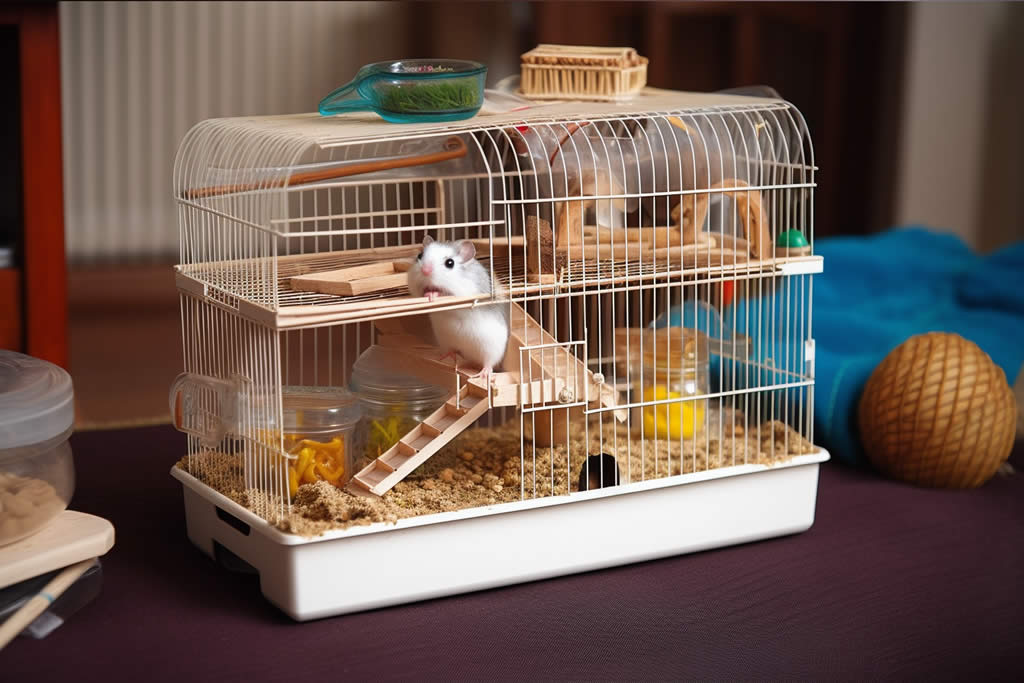Picture this: 3AM, you’re crawling under your bed chasing an escaped Syrian hamster named Houdini, questioning every life choice that led to this moment. After 7 cages and $600 down the drain, here’s my uncensored guide to avoiding hamster housing disasters.
The Great Cage Debate: Real-World Pros & Cons
Wire Cages
My Experience: Bought the cute pink one. Regret level: 11/10
| Feature | Store Description | Reality |
|---|---|---|
| Ventilation | “Breathable!” | Bedding dust storms |
| Attachable Toys | “Customizable!” | Chewed plastic death traps |
| Cleaning | “Easy access!” | Screwdriver required for tray |
Pro Tip: Measure bar spacing with a credit card. If it fits sideways, so will your hamster.
Plastic Habitrails
My Disaster: Looked like a hamster spaceship. Became a pee labyrinth.
Cost vs. Function
| Component | Promised Use | Actual Use |
|---|---|---|
| Colorful Tubes | “Fun exercise!” | Mold growth highways |
| See-Through Doors | “Cute visibility!” | Scratch marks obscure view |
| Modular Design | “Expandable!” | Leaks at every joint |
Lesson Learned: Bought stock in enzyme cleaner.
Glass Tanks
My 40-Gallon Regret:
The Good
- Instagrammable
- Contains bedding flingers
The Bad
- Weighs more than my ex’s ego
- Condensation = hamster sauna
The Ugly
120“habitat”becamea120“habitat”becamea25 Craigslist post after 2 months
Size Matters: The Dirty Truth About Minimum Requirements
Why 450 sq.in is BS
Real-World Testing Data
| Cage Size | Hamster Behavior | Owner Sanity Level |
|---|---|---|
| Pet Store “Large” | Pacing & bar chewing | Constant guilt trips |
| 600 sq.in | Occasional zoomies | Mild anxiety |
| 1000+ sq.in | Actual burrowing | “Why didn’t I do this sooner?!” |
DIY Hack: Convert an IKEA Detolf cabinet ($65) into a hamster mansion.
The 5 Cage Features You’ll Actually Use
- Deep Base Trays
- Minimum 6” depth
- Prevents bedding avalanches during cage WWE matches
- Front-Opening Doors
- No more hand contortions
- Essential for grabbing escape artists mid-sprint
- Removable Platforms
- Customizable layouts
- Saves hours scrubbing glued-on poop
- Solid Wheel Mounts
- Silent spins > squeaky nightmares
- Prevents 2AM “ghost wheel” phenomena
- Chew-Proof Latches
- Foils furry Houdinis
- Worth paying extra for
Budget Breakdown: Where to Splurge & Save
The Hamster Tax
| Item | Cheap Version | Smart Upgrade |
|---|---|---|
| Water Bottle | $3 leaky dripper | $9 glass anti-chew |
| Hideout | $5 plastic igloo | $0 terracotta pot |
| Bedding | $8 kiln-dried pine | $12 hemp + torn paper |
| Wheel | $15 “quiet” spinner | $35 wooden silent runner |
Confession: Spent more on vet bills from cheap cage injuries than mortgage payments.
Cage Comparison: Beyond the Sales Pitch
Top 5 Cages Rated by Escape Attempts
| Model | Setup Time | Escape Resistance | Noise Level |
|---|---|---|---|
| Niteangel Stacker | 45 min | Fort Knox | Library |
| IKEA Detolf Hack | 2 hrs | Moderate | Slight echo |
| Kaytee CritterTrail | 20 min | Sieve | Jet engine |
| Bin Cage DIY | 1 hr | Variable | Muffled |
| Prevue 528 | 30 min | Medium | Squeaky |
The 24-Hour Test: What Pet Stores Hate
- Odor Check
Leave empty cage closed for a day. Funky smell? Poor ventilation. - Chew Test
Rub carrot on bars. Stains? Coating will flake off. - Ramp Rally
Test inclines with marble. Rolls freely? Toe trap waiting to happen. - Escape Simulation
Push cotton ball through bars. If it fits…
When to Break the Rules
“Minimum Size” Exceptions
- Dwarfs in groups need 1200+ sq.in
- Female Syrians require 1500+ (they’re Beyoncé in fur form)
- Elderly hams need single-level setups
Material Hacks
- Line plastic cages with tile samples
- Use chalkboard paint on glass for stress-free monitoring
Final Checklist Before Buying
✅ Measured bar spacing with actual hamster
✅ Test assembled friend’s cage first
✅ Budgeted for inevitable upgrades
✅ Accepted this will be wrong in 6 months



